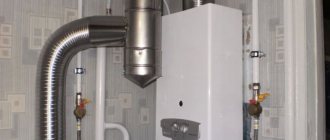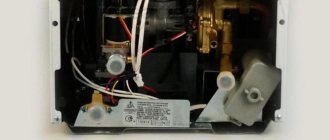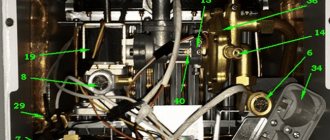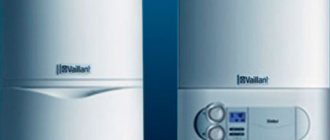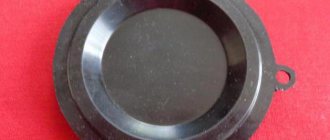To ensure a regular supply of hot water for their home or apartment, many owners install a gas water heater in the kitchen. The device is compact, does not take up much space on the wall, and even a teenager can understand the principle of operation.
Such water heating equipment will serve its owner “faithfully” for decades, but only with proper operation and periodic cleaning. How to rinse and clean a gas water heater with your own hands at home (for example, the Zanussi GWH 10 Fonte Glass Rialto model)? Detailed information is provided in the article.
Why do the “insides” of the gas water heater become clogged?
The reason for such contamination lies in the operating principle of the device. The device heats water using gas, and therefore accumulations of soot and deposits cannot be avoided. In addition, the incendiary element itself very often becomes dirty, collecting soot on its wick.
But the real apocalypse comes when scale “settles” in the water heater pipes. It not only interferes with the normal operation of the equipment, but can even disable it completely, completely clogging the water supply part. The appearance of scale in the heat exchanger is especially dangerous.
The heat exchanger is a collection of tubes placed above a gas burner. Water must flow through them constantly and unhindered; it is in them that it heats up evenly. When scale accumulates in these pipes, interruptions in the supply of hot water occur.
You might be interested in: 9 important questions when choosing a geyser
It's time to cleanse: the first signs
You can determine that a geyser (for example, from Bosch) needs cleaning based on 4 characteristic signs:
- The device stops turning on or often goes out during operation . When there is 100% confidence that gas is supplied to the column uninterruptedly, and water flows with a stable pressure, the reason for such independent shutdowns may be an excessive amount of burning on the ignition element. The problem can only be resolved by cleaning the burner.
- The thermal protection of the device is activated . To prevent the column from overheating, the equipment is equipped with a thermal sensor. It signals an increase in temperature, warning the owner of a malfunction. If this sensor is triggered frequently, it is worth cleaning the pipes from scale. Since scale has good thermal insulation, it interferes with the normal cooling of the device.
- The productivity of the device has decreased for no apparent reason . If the water begins to heat up more slowly or the pressure level drops significantly, you need to check the heat exchanger for scale and clean out the accumulated products of the column.
So, it’s clear that the device is dirty, but how can you clean the geyser from scale and soot when such a need arises? The answers are in the following sections of the article.
Conclusions and useful video on the topic
An interesting option for flushing a gas water heater can be found in this material:
The procedure for cleaning the heat exchanger without dismantling is demonstrated here:
This video shows an interesting experiment on dissolving scale in electrolyte, citric acid and vinegar. Although it is necessary to take into account not only the effect of chemistry on the hard sediment, but also on the material from which the heat exchanger is made:
Any geyser needs periodic cleaning. If maintenance is performed correctly, the device will work long and efficiently.
Would you like to talk about how you cleaned a gas instantaneous water heater yourself? Do you have information on the topic of the article that will be useful to site visitors? Please write comments in the block below, ask questions and post photos on the topic of the article.
Gas-powered devices require timely and careful maintenance. To clean a geyser from combustion products and scale, which inevitably accumulate on the walls and reduce the performance of the device, it is not necessary to call specialists to your home; almost all stages of cleaning can be carried out independently.
Gas water heater cleaning products
The rules for caring for a gas water heater are described in detail in the instructions for the device, and deviating from these requirements can be dangerous. If the water heater suddenly becomes clogged, you should use only products recommended by the manufacturer to clean it. They should also be indicated in the relevant paragraphs of the instruction manual. And it is better to entrust the cleaning process to professionals. In this case, not only will the blockage be eliminated, but the warranty will also be preserved.
Important ! Unauthorized reading using unauthorized means is dangerous to health! If during the process of descaling or burning one of the elements of the column is damaged and a gas leak appears, you must immediately call 104.
Only if the user understands all the possible consequences and accepts responsibility can he clean the device himself. What and how to rinse a geyser (for example, Ariston brand) from scale in this case? You can also use ready-made drugs or traditional methods. What is better and more effective: “vigorous” chemistry or “grandmother’s” cleaning, the comparison table will show:
| Solves the problem | Folk remedy | Chemical drug |
| Scale inside the heat exchanger | A mixture of 0.5 liters of hot water and 100 g of citric acid. | Calgon or Antiscale (corrodes layers of scale inside pipes). |
| A dense layer of carbon deposits (can only be removed from the heat exchanger; the gas part is cleaned by specialists) | Dilute table vinegar and warm water in a ratio of 1:3. | You can use 7-10% hydrochloric acid or other strong chemicals. Important! The work requires care: under no circumstances should the product come into contact with the skin or mucous membranes. |
Descaling: work order
To carry out such manipulation, you can use both folk remedies and chemical solutions. Having cast your vote in favor of chemistry, you must follow the instructions exactly. If you choose citric acid or vinegar, then the work consists of the following steps:
- the gas water heater is turned off;
- the heat exchanger is disconnected by hand from the remaining elements and removed from the wall, the water is drained from it;
- at the same time connect a hose to the pipe that supplies water to the column to avoid leaks;
- using a bulb, syringe or watering can, the resulting solution is poured into the heat exchanger pipes;
- Now the heat exchanger body is lowered into a deep basin with the same mixture and left in this state for several hours or overnight.
After this, the part must be rinsed well under running water, connected back to the column (optionally, the column of the Ariston FAST R ONM model) and then start the device. Pressurized water will remove all scale, leaving the pipes perfectly clean.
Nuance : It’s easy to check the effectiveness of your work - just look at the color of the water: if it is transparent, then all the scale has come out.
Anyone who dreams of a new device will be interested in reading: Replacing an old gas water heater with a new one: 5 important points
Is it possible to clean the heat exchanger without dismantling it?
The immediate answer is: “Yes, you can.” To do this, you need to remove the front protective panel and disconnect the heat exchanger from the pipe that supplies water to the gas water heater. A drain hose is connected in its place.
When these preparatory procedures are completed, any chemical agent (or folk composition, if desired) is taken and poured into the heat exchanger pipes through the inlet. You should fill the “insides” slowly, in a thin stream, to avoid a sharp reaction and pushing the product back out.
The device is left in this form for 2-3 hours. After the time has passed, you need to reconnect the hose and drain the waste water with scale and other impurities. Then turn on the column and check its operation.
Electromechanical methods for descaling
To clean the heat exchanger spiral from scale, you can use the mechanical method of supplying a cleaning solution under pressure; in suburban conditions, it is effective to use a mini-high-pressure washer for this purpose, while the water heater is disassembled.
You can also speed up the cleaning process using a small-sized centrifugal electric pump or vibration pump (many people use a unit from an old washing machine). To do this, electric pumping equipment is connected to the inlet of the coil and a container with a cleaning solution, and the liquid from the outlet is drained into the main tank with anti-scale, thereby ensuring circulation of the composition in a circle. The use of an electric pump significantly speeds up the process and improves the quality of cleaning - the liquid is passed through a coil with increased pressure, which promotes effective removal of scale.
Options for connecting pumps and pumps for cleaning the heat exchanger
Removing soot and soot
It is better to entrust cleaning of a gas water heater (for example, the Bosch Therm 4000 O WR model) from combustion products, as well as from scale, to professionals, especially when the device is under warranty. You can independently remove only soot from the surface of parts without disassembling the gas part. How to do it? The process takes 10-15 minutes and consists of the following steps:
- the gas supply is turned off and the upper housing is removed;
- all internal elements are carefully wiped with a cloth or cleaned with a vacuum cleaner;
- the casing is installed back and the functionality of the device is checked.
If the gas wick starts to burn weakly, it means the nozzle is clogged. It is located on the gas manifold, next to the pressure sensor. You can clean the nozzle with a regular thin wire and a stiff brush. Upon completion of work, be sure to check the element for gas leaks. To do this, you need to lubricate the burner with soapy water (bubbles appear when there is a leak).
Checking the proper operation of the gas water heater with your own hands
Malfunctions in the operation of the gas water heater can occur due to a lack of draft, and this indicates problems in the operation of the chimney. Modern models of dispensers have special sensors built in - they immediately stop the gas supply. Other models can be checked this way:
- Use any fire source to check the condition of the chimney.
- A column with good draft will extinguish the fire or will pump it strongly.
- With bad traction, nothing will happen. You need to call the appropriate services.
All these recommendations on how to clean a gas water heater with your own hands will certainly be useful to you. But we want to warn you: if you do not have sufficient skills in assembling and disassembling equipment, if your speaker is too old or has a complex design, do not try to save money! Call a professional technician who will do all the work properly. Otherwise, any mistake you make can lead to very sad consequences!
To operate the dispensers, liquefied or natural gas is used, which after some time inevitably leads to contamination of the dispenser. Preventive maintenance is an important part of ensuring that your device operates correctly and efficiently. Many owners prefer to clean their speakers themselves. Cleaning the speaker must be very careful, since the safety of the owners of the living space depends on it.
Prevention is better than cleaning
Prevention is necessary to prevent scale, which is the main scourge of geysers (for example, such as Zanussi water heaters). It appears not only as a result of salt deposits from hard water, but also as a result of constant high temperature in the device. To ensure that the pipes are clogged with this “muck” as little as possible, it is necessary to set the optimal temperature.
Another way to prevent scale is to install water purification filters or electric softeners. They do not allow harmful salts to pass through, allowing the heat exchanger pipes to last longer. However, the cleanliness of the filter and electric softener also needs to be monitored.
You might be interested in: TOP 10 geysers of 2017
Preventing scale formation
Hard water is not the only reason for scale to appear inside the heat exchanger tubes. For its appearance, you need not only the salts contained in the water, but also a high heating temperature. The hotter the gas burns, the more intense the solid deposit inside the device. Temperatures of 80 degrees or higher are considered critical.
Obviously, such high heating is not needed for domestic use. For a shower, 40-42 degrees is enough; for washing even the dirtiest dishes, 45 degrees is enough. An automatic washing machine will heat the water up to 95 degrees, if necessary, but the gas water heater does not participate in this process in any way.
Therefore, if hot water constantly has to be diluted with cold water, it is worth reviewing the settings of the geyser for heating temperature. Some amateur craftsmen drill out the igniter of a gas water heater. This is done in order to increase the heating rate of the water flow.
In older models, this modification eliminates the need to light up and adjust the device every time you turn it on. Finally, a drilled igniter is needed to ensure that the gas ignites even with very low water flow pressure.
In this case, a very dangerous situation can arise when a small amount of water in the heat exchanger boils and goes into gaseous form. As a result, the pressure in the heat exchanger will increase sharply and it will simply burst.
Of course, gas workers consider such intervention dangerous, and manufacturers refuse to fulfill warranty obligations for devices with such modifications. To improve the pressure in the system, you can select and install a conventional circulation device or a booster pump. And the quality of the water supply will improve, and the devices will not be damaged.
